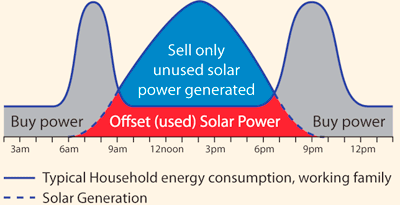Solar Power Products
EcoSmart - We're here to help
Buying a solar power system is the most advanced technology purchase you will ever make. It consists of highly complex electrical circuitry. The system’s finely balanced component performance is essential to harnessing the sun and converting it into usable energy. We insist on excellence and the highest standards of quality control.
EcoSmart provides an affordable, independent energy lifestyle.
How does solar power work













Click to begin animation
- 1 Solar panels convert sunlight into DC electricity.
- 2 The DC electricity is fed into your inverter which converts it into 240 volt AC electricity to power your home.
- 3 The solar electricity your system generates is used by appliances in the home.
- 4 Any excess electricity is recorded by your power meter and immediately fed back to the grid.
- 5 At night, or if your demand exceeds what your home is generating, power is drawn from the grid.
How do I make money from solar?
What is a feed-in tariff?
A feed-in tariff is offered by each of the State Governments and utility suppliers. They pay you a premium rate for electricity generated by your solar PV system that is fed back into the grid and offsets the need to generate it at the power stations.
Net Tariff
A net feed-in tariff is when you’re paid a premium rate for any excess electricity (whatever you don’t use) that’s fed back into the grid. The less power you use during the day the more gets fed back into the grid.
Net Tariff: Solar generation supply and demand

Surplus electricity generated during the day is exported (sold) and credited to your account at a premium rate.
How much power does it actually make?
The below graph explain the average daily production of Kilowatts (kW) within most Metro area of Australia.
| City | 1 kW system | 1.5 kW system | 2.0 kW system | 3.0 kW system | 4.0 kW system |
|---|---|---|---|---|---|
| Adelaide | 4.2 kWh | 6.3 kWh | 8.4 kWh | 12.6 kWh | 16.8 kWh |
| Alice Springs | 5.0 kWh | 7.5 kWh | 10.0 kWh | 15.0 kWh | 20.0 kWh |
| Brisbane | 4.2 kWh | 6.3 kWh | 8.4 kWh | 12.6 kWh | 16.8 kWh |
| Cairns | 4.2 kWh | 6.3 kWh | 8.4 kWh | 12.6 kWh | 16.8 kWh |
| Canberra | 4.3 kWh | 6.45 kWh | 8.6 kWh | 12.9 kWh | 17.2 kWh |
| Darwin | 4.4 kWh | 6.6 kWh | 8.8 kWh | 13.2 kWh | 17.6 kWh |
| Hobart | 3.5 kWh | 5.25 kWh | 7.0 kWh | 10.5 kWh | 14.0 kWh |
| Melbourne | 3.6 kWh | 5.4 kWh | 7.2 kWh | 10.8 kWh | 14.4 kWh |
| Perth | 4.4 kWh | 6.6 kWh | 8.8 kWh | 13.2 kWh | 17.6 kWh |
| Sydney | 3.9 kWh | 5.85 kWh | 7.8 kWh | 11.7 kWh | 15.6 kWh |
Data Source: PV-GC spreadsheet based on the CEC GC Design Guidelines.
PV Array 1kWp facing true north and a tilt angle of 20° with an average inverter / wiring effi ciency – 0.92, using long term average solar irradiation and temperature data from the Australian Solar Radiation Data Handbook. A typical Australian house consumes around 18 kilowatt hours (kWh) per day so a 1-2kW system displaces an average of 25-40% of your average electricity bill. Solar panels produce more energy in summer than they do in winter.









